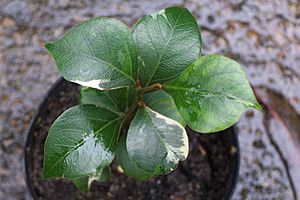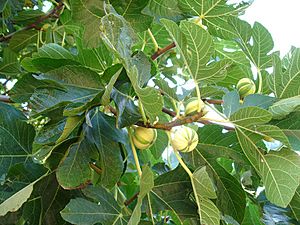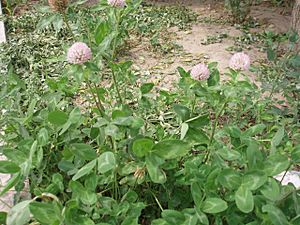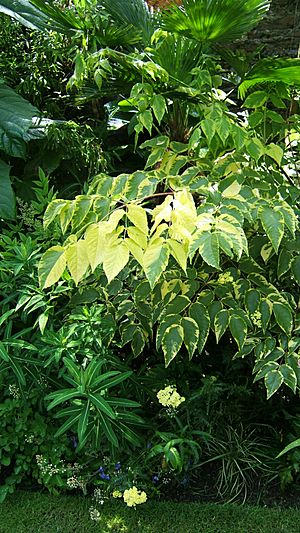Variegation facts for kids

Variegation is when parts of a plant's leaves, stems, or even fruit have different colors. Imagine a leaf that's not just green, but has patches of white, yellow, or pink! This often happens in plants found in tropical rainforests. Many popular houseplants have this special look.
Variegation can be caused by tiny changes in the plant's cells, called mutations. These changes affect how the plant makes chlorophyll, which is the green stuff in plants. Sometimes, tiny viruses can also cause these patterns. Gardeners really love variegated plants because they look so unique and beautiful.
Contents
What Makes Plants Variegated?
Different Plant Tissues

Some variegated plants are called chimeras. This means they have two different types of plant tissue growing together. One type of tissue makes chlorophyll (so it's green), and the other type doesn't (so it's white or yellow).
If you want to grow more of these chimera plants, you need to use special methods. For example, taking cuttings from the stem usually works. But if you try to grow them from root cuttings, they might lose their cool patterns.
Light Tricks on Leaves
Sometimes, variegation isn't about different colors, but about how light bounces off the leaf. This can happen if there's a tiny layer of air just under the leaf's skin (called the epidermis). This air layer makes the leaf look white or silvery. The Pilea cadierei, also known as the aluminum plant, is a good example of this.
Other plants, like many Cyclamen species, have patterns that look like they're painted on. These patterns are different for each plant but stay the same on all leaves of that one plant. Some Begonia plants have hairs on their leaves that are different colors, which also creates a cool variegated look.
You might also see variegation along the veins of a leaf. This happens when the tissue right above the veins doesn't have green chlorophyll. Some plants like the blessed milk thistle show this effect.
Natural Plant Colors

Another common reason for variegation is when other colors hide the green. Plants have different pigments (natural colors) besides chlorophyll. For example, anthocyanins can make leaves look reddish or purplish.
On some plants, like certain clovers or Pelargonium species, these colorful patterns appear in specific areas. The patterns on Coleus plants can be very different from one plant to another, making each one unique!
Plant Sickness or Stress
Sometimes, patterns appear on leaves because of virus infections. These patterns often look like a mosaic (a picture made of small pieces). An example is the citrus variegation virus (CVV).
There's also a virus called Hosta virus X (HVX) that causes mottled (blotchy) leaf colors in hostas. Even though these diseases can be serious, some affected plants can still look attractive and are grown for their beauty, like certain variegated Abutilon varieties.
Plants can also show temporary yellowing if they don't get enough important nutrients like iron or magnesium.
Plant Camouflage
Some scientists think that certain leaf patterns might help plants protect themselves. These patterns might make the leaf look like it's already been eaten by an insect, which could trick other insects into leaving it alone! It's like a natural disguise.
How Gardeners Use Variegated Plants

Gardeners have loved variegated plants for a long time. Their lighter colors can make a garden look more interesting, breaking up large areas of solid green. Many gardening groups focus on these special plants. There are even books written just about variegated plants!
These unique plants can be very valuable. For example, in 2020 and 2021, some rare variegated Rhaphidophora tetrasperma plants sold for thousands of dollars at auctions!
See also
 In Spanish: Variegación para niños
In Spanish: Variegación para niños
- Glossary of botanical terms

